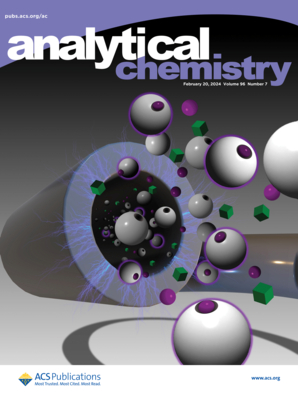Chiral Carbon Dots as Optical Probes: Selective Detection of Acetylcholinesterase via Enhanced Photoluminescence.
IF 6.7
1区 化学
Q1 CHEMISTRY, ANALYTICAL
引用次数: 0
Abstract
Acetylcholinesterase (AChE), one of nature's most efficient enzymes, plays a crucial role in neural signal transduction and the restoration of tissue homeostasis with implications in the development of neurodegenerative diseases. Conventional methods for detecting AChE mainly rely on its catalytic activity. Herein, we present an approach for AChE detection based on its chiral binding with photoluminescent carbon dots (CDs) with rich chiral cysteine residues (L/D-CDs), synthesized via a general hydrothermal route. Interestingly, L-CDs, despite being synthesized under the same conditions as D-CDs, exhibited a stronger specific binding affinity for AChE than D-CDs through electrostatic interactions, attributed to the amphiphilic nature of AChE, leading to enhanced photoluminescence near the isoelectric point of AChE at 6.50. The enhanced photoluminescence intensity of L-CDs showed a linear correlation with AChE concentrations over the range of 200-4500 mU/mL with a detection limit of 20 mU/mL. Meanwhile, by leveraging the selective recognition of AChE by L-CDs, we applied the probe to distinguish between liver cancer tissues and adjacent nontumor tissues. The results demonstrated that, due to the reduced AChE content in liver cancer tissues, the fluorescence intensity was significantly lower than that in adjacent nontumor tissues. Our findings highlight the potential of CDs rich in chiral residuals as optical probes for biosensing and imaging applications based on biomolecular recognition.手性碳点作为光学探针:通过增强光致发光选择性检测乙酰胆碱酯酶。
乙酰胆碱酯酶(AChE)是自然界最有效的酶之一,在神经信号转导和组织稳态恢复中起着至关重要的作用,与神经退行性疾病的发生有关。传统的检测乙酰胆碱酯酶的方法主要依靠其催化活性。在此,我们提出了一种基于其与具有丰富手性半胱氨酸残基(L/D-CDs)的光致发光碳点(CDs)的手性结合的检测方法,该方法通过一般的水热方法合成。有趣的是,尽管L-CDs与D-CDs是在相同的条件下合成的,但由于AChE的两亲性,L-CDs通过静电相互作用对AChE表现出比D-CDs更强的特异性结合亲和力,导致AChE在6.50等电点附近的光致发光增强。L-CDs的增强光致发光强度与AChE浓度在200 ~ 4500 mU/mL范围内呈线性相关,检出限为20 mU/mL。同时,利用L-CDs对AChE的选择性识别,我们将探针应用于肝癌组织和邻近非肿瘤组织的区分。结果表明,由于肝癌组织中AChE含量降低,荧光强度明显低于邻近非肿瘤组织。我们的研究结果强调了富含手性残基的CDs作为基于生物分子识别的生物传感和成像应用的光学探针的潜力。
本文章由计算机程序翻译,如有差异,请以英文原文为准。
求助全文
约1分钟内获得全文
求助全文
来源期刊

Analytical Chemistry
化学-分析化学
CiteScore
12.10
自引率
12.20%
发文量
1949
审稿时长
1.4 months
期刊介绍:
Analytical Chemistry, a peer-reviewed research journal, focuses on disseminating new and original knowledge across all branches of analytical chemistry. Fundamental articles may explore general principles of chemical measurement science and need not directly address existing or potential analytical methodology. They can be entirely theoretical or report experimental results. Contributions may cover various phases of analytical operations, including sampling, bioanalysis, electrochemistry, mass spectrometry, microscale and nanoscale systems, environmental analysis, separations, spectroscopy, chemical reactions and selectivity, instrumentation, imaging, surface analysis, and data processing. Papers discussing known analytical methods should present a significant, original application of the method, a notable improvement, or results on an important analyte.
 求助内容:
求助内容: 应助结果提醒方式:
应助结果提醒方式:


